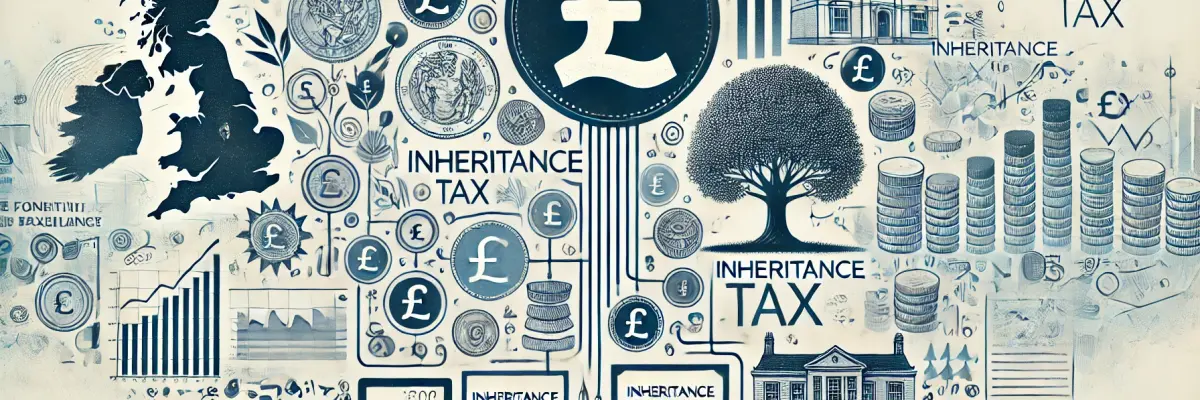Inheritance Tax
- Lee Wisener
- 13-10-2024
- Tax Guides
An inheritance tax is a tax on assets passed down after death. It impacts property, money, and possessions, with rates depending on the estate’s value and the heir’s relationship to the deceased. Knowing how it works is key for effective estate planning.

Table of contents
A Beginner’s Guide to UK Inheritance Tax: What It Is and How to Avoid Nasty Surprises
Inheritance tax – the tax that sneaks up on you just when you thought the taxman was done with you. Whether you’re planning your estate or dreading the day you have to deal with one, understanding UK inheritance tax (IHT) is crucial. But don’t worry, I’ll break it down for you in simple terms, with a dash of humor to keep things lively.
What Is Inheritance Tax?
An inheritance tax is exactly what it sounds like: a tax on the estate (everything owned) of someone who has passed away. The government takes a slice before the rest is passed on to the heirs. Sounds fair, right? Well, that depends on which side of the tax you’re on!
The current threshold for inheritance tax in the 2024/25 tax year is £325,000, just like before. This means that if the value of the estate is below this, no tax is payable. But if it’s above this threshold, HMRC (the UK tax office) will be knocking on your door, asking for a 40% cut of anything over that amount. Yes, you read that right – 40%.
How to Calculate Inheritance Tax
Let’s dive into an example to make it clearer.
Imagine Aunt Mildred, bless her heart, leaves you an estate worth £600,000. Here’s how the inheritance tax would be calculated:
Step 1: Determine the Taxable Amount
- Estate Value: £600,000
- Tax-Free Threshold: £325,000
- Taxable Amount: £600,000 - £325,000 = £275,000
Step 2: Apply the Tax Rate
- Inheritance Tax Due: 40% of £275,000 = £110,000
So, the taxman would take £110,000, leaving you with £490,000. It's not too bad, but it’s always nice to keep as much as possible, right?
Ways to Reduce Your Inheritance Tax Bill (Legally!)
No one likes paying more tax than they have to, especially not when it comes to inheritance. Luckily, there are several ways to reduce your IHT bill, and they’re all above board.
The Nil Rate Band (NRB) and Residence Nil Rate Band (RNRB):
The basic tax-free allowance is still £325,000, known as the Nil Rate Band. But there’s an extra perk if you’re leaving your home to direct descendants (like children or grandchildren) – an additional Residence Nil Rate Band of up to £175,000. This could bring the total tax-free amount to £500,000 for individuals or up to £1 million for a couple.
Gifting:
One way to reduce the size of your estate is by giving away assets during your lifetime. Gifts made more than seven years before your death are usually exempt from IHT. But be careful – if you give away your house but still live in it without paying rent, HMRC might still consider it part of your estate (cheeky, I know).
Charitable Donations:
Leave 10% or more of your estate to charity, and the inheritance tax rate on the rest of your estate drops from 40% to 36%. Plus, you get to feel good about helping a good cause.
Life Insurance:
Taking out a life insurance policy in trust can cover the IHT bill, so your heirs don’t have to dip into the estate to pay it.
Spouse or Civil Partner Exemption:
Anything left to your spouse or civil partner is generally exempt from IHT. And if they don’t use their full allowance, it can be passed on to the surviving partner, effectively doubling the threshold.
Inheritance Tax on Property
The family home often makes up a significant portion of the estate’s value, which can tip you over the IHT threshold. This is where the Residence Nil Rate Band comes in handy. However, be aware that this only applies if you leave the property to a direct descendant, and the allowance is tapered if your estate is worth over £2 million.
Example:
Let’s say you leave a house worth £700,000 to your daughter. If you qualify for both the NRB (£325,000) and the RNRB (£175,000), that’s £500,000 tax-free. You’d only pay inheritance tax on the remaining £200,000, which would be £80,000 (40% of £200,000).
What Happens if You Can’t Pay the Inheritance Tax?
Inheritance tax is usually due within six months of the person’s death, but if the estate doesn’t have enough liquid assets (like cash or shares) to cover it, you might be allowed to pay in instalments over 10 years. However, interest will be added, so it’s not a free lunch.
Summary
Inheritance tax planning isn’t the most exciting task, but a little effort now can save a lot of money later. Whether it’s making gifts, setting up a trust, or simply being aware of the thresholds and allowances, there’s plenty you can do to ensure the taxman doesn’t take more than his fair share.
As always, seek professional advice. The cost may be far less than the savings you could make.
Lee Wisener
I am the Admin of this site. I created it from scratch, and I made all the content. The bottom line is that I'm it if you're looking for the person responsible! We now have a new support system, please log in and use it rather than email where possible.



Comments (0)
Want to comment on this page? Login or Register.